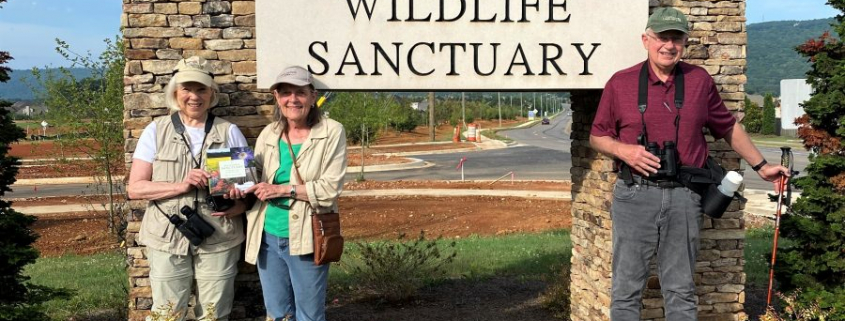Visiting a Southern Sanctuary: Nature’s Insistence Upon Renewal
I visited the Goldsmith Schiffman Wildlife Sanctuary June 6 and presented my reactions, reflections, and photographs in a June 23, 2020 Blog Post: https://stevejonesgbh.com/2020/06/23/visiting-a-southern-sanctuary-my-orientation-visit/
Please see that earlier Post for general information about the Sanctuary. I’m following up now with a second Post, this one focusing on what I’ll term Nature’s insistence upon renewal. Suffice it to say that the Sanctuary is not preserving 375 acres of wilderness. Instead, the Goldsmith-Schiffman families worked the land for generations, including farming, timbering, and even mining sand and gravel for use as fill for highway construction west of the Sanctuary decades ago. Despite active human operation for many years, Nature is returning the land to a state of wildness from that sometimes harsh treatment few would surmise today from a walk through this riparian oasis. A wonderful sign welcomes visitors. Marian Moore Lewis chronicled the Sanctuary’s seasons in Southern Sanctuary, an exquisite month-to-month journey through this wonderfully wild one-half square mile along the Flint River within Huntsville, Alabama’s city limits.
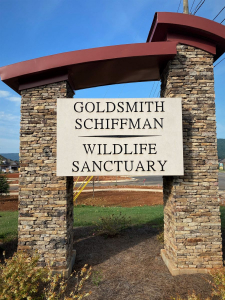
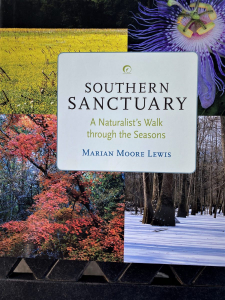
From the interpretive sign (site of the future Interpretive Center) we walked the Hidden Springs Trail… through the red gate, passing Hidden Springs (below). Clear water flows to the surface at this point.
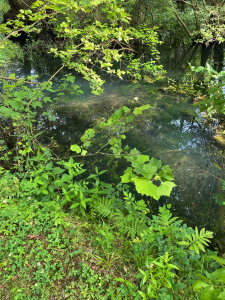
Hidden Springs feeds Jobala Pond, a name derived from the combination of the first two letters from the names of Margaret Anne Goldsmith’s (she donated the land for the Sanctuary) three children. My earlier Post tells the full story of Nature’s grand design in naturalizing this former borrow pit, creating natural beauty from a deep scar upon the land.
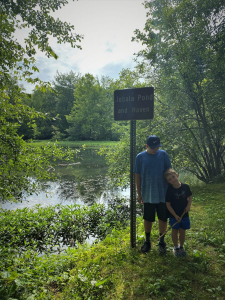
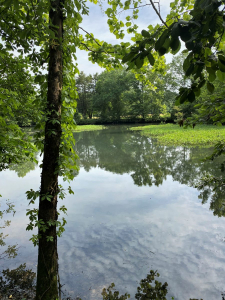
I felt that this brief paragraph and the accompanying two photos below merited repeat in this Post. Forgive my shameless self-plagiarizing! A smaller borrow pit pond (I dubbed it Murky Pond) presented a different face. Hidden Spring enters and flows through Jobala; my sense is that a high water table (without obvious through-flow) feeds Murky, which is accessed at Forest Glen Observation Point. Marian observed that the muddy entrance chute (below right, lower center) is a muskrat slide, where these water habitat-dwelling mammals enter and exit the pond. We speculated why the water is so stirred and turbid. First, there is no apparent surface refresh like there is with Jobala. The muskrat occupants may keep the water disturbed. Or even large carp. Or a gator? We’ll leave solving the mystery to another day.
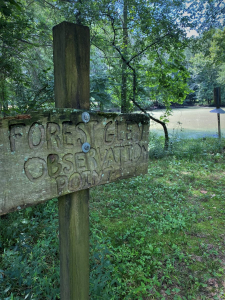
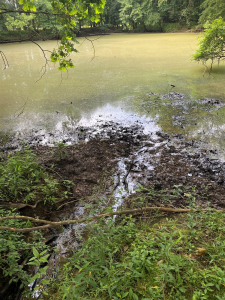
Having covered some of the same content as the prior Post, I will now shift gears to material unique to this Post.
The Elegant Dance of Life and Death: Fungi Kingdom
Leonardo da Vinci expressed timeless wisdom 500 years ago. I offer several of his still-relevant quotes within this Post. I’ll launch this section on life and death with his statement of powerful simplicity:
Our life is made by the death of others.
I write often of the ongoing marvel of Nature’s interwoven and continuous tale of life and death. Nothing in Nature is static; all life ends in death…the cycle repeats without end. Whether the Sanctuary’s visible life persists as plant or animal, the fungi kingdom (neither plant nor animal) serves as the grand parade marshal, ushering even the largest oak from main canopy stalwart through decay to forest soil organic matter. I admit to far less certainty in identifying our northern Alabama fungi. In fact, iNaturalist, my online source of i.d. for all things living, declared this to be California fungi (Pluteus petasatus), an odd moniker for a location more than 2,000 miles from its namesake!
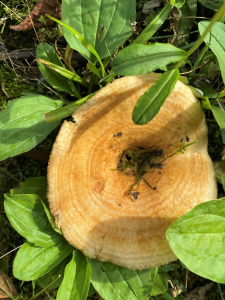
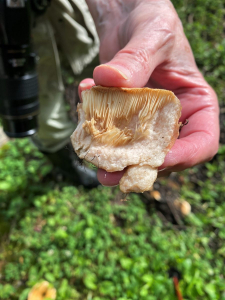
I suppose what is most important is that this mushroom is the reproductive (spore-producing) structure of the fungi’s mycelia feasting on dead organic matter in the forest floor substrate.
I identified Marian Moore Lewis (without the assistance of iNaturalist), local author (Southern Sanctuary) and naturalist, in the prior Post. A talented photographer, Marian stopped to capture the image of yet another mushroom. So many casual hikers (and some who are serious) walk through the forest, blind to the many rewards that lie hidden in plain sight. We wandered these trails with purpose, intent to miss little. We hike in the forest, not simply passing through it!
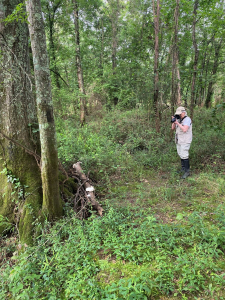
This specimen is false turkey tail (Trametes cubensis). The largest of this colony measures six inches across. Its mycelia are feeding on the branch. I wonder how many more years (months?) until its work is done… until the branch no longer has form and structure, and disappears into the soil matrix, to help fuel the next tree that will grow to shed yet another branch to feed future generations of Trametes cubensis.
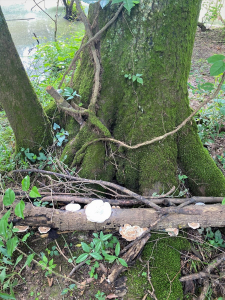
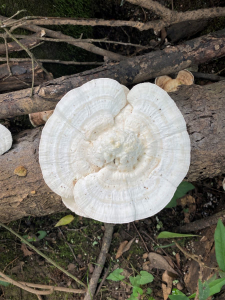
Grandson Sam (age six) poses with a decaying stem segment supporting a rich community of lichens and fungi. I will attempt no finer identification beyond noting that the white mushroom at the near end is a polypore, and a fine specimen it is. I admit that I am including this photograph mostly because it is a cute picture. Perhaps Sam will grow to be a noted mycologist who with a single glance back at Pap’s ancient Blog Posts will roll the genus and species effortlessly from his tongue. Better yet, perhaps he’ll remember the Goldsmith Schiffman hike with fondness and warmth.
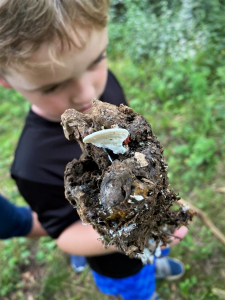
I spotted this distinctive Boletes (Boletus sp.) mushroom at the base of a sugarberry (Celtis laevigata). Its mycelia are feeding on organic matter in the soil. Note the thick moss mat on the tree’s two visible feet. As I’ve observed often, the microclimate at the base of our main canopy trees is perfect for the mosses — cooler with higher humidity. The flared and sometimes buttressed lower trunk also tends to slow stem flow during heavier rains, depositing the water’s load of organic debris and nutrients on the bark surface and in micro-crevices, creating a more favorable substrate for the moss. Watch for our moss-bottomed trees the next time you walk into your favorite forested wildness.
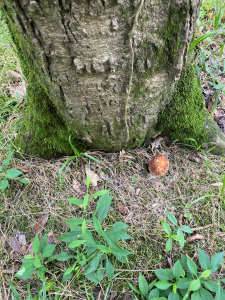
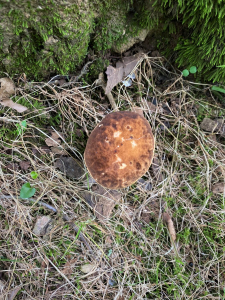
We found a colorful wood ear fungus, this one identified by iNaturalist as jelly ear (Auricularia auricula-judae), a perfect moniker for a very ear-like mushroom. How sad to think that a person could walk the trail distracted by digital interference and not see these showy specimens. Remember, these are decay organisms consuming cellulose and lignin. Behold the beauty of these essential, noble saprophytes. Who says there is no wonder in decay!
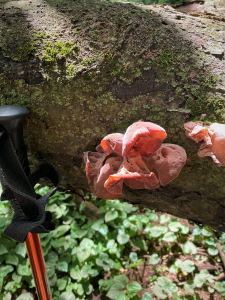
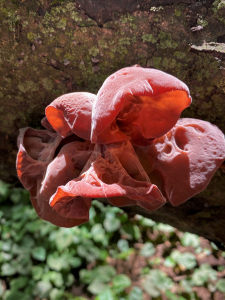
Another jelly fungus greeted us from yet another downed tree. Again, I offer these identifications without the confidence I bring to naming trees, woody shrubs, and spring wildflowers. This one surfaced as leafy brain (Phaeotremella foliacea). What a delightful assortment of life forms, colors, and zany nomenclature: jelly ear and leafy brain. Where is Dr. Seuss when you need him?
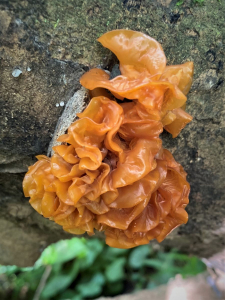
I entered the forest, my eyes to the trees;
I heard the leaves rustle, felt the slight breeze.
Yet as I looked up, saw the canopy high;
I sensed a presence below me, quiet and shy.
Something heeding my passage, with a tremble of fear;
Perhaps hearing my footfalls with keen jelly ear.
And registering a threat as I passed in the lane;
Via synapses firing within leafy brain.
The fungi range wide in these forested glens;
From Trametes to Boletes they bless our eye lens.
With colors diverse in the shadows and lights,
They’re doing their duty… these forest saprophytes.
Yeah, I know, I’m no Dr. Seuss, yet it is fun to think of the tale he could have woven poetically about fungal life in the understory.
Other Life and Renewal
Fungi did not attract our sole attention that day. Far more awaited our discovery.
A side note: As I prepared for a Facebook Live video presentation June 25 at Hays Nature Preserve, just across route 431 from the Sanctuary, an acquaintance inquired, given the current social strife, whether I would be discussing “diversity, inclusion, and equity.” My answer stuck to the natural world — I would limit my topic to whatever elements of Nature captured my fancy that afternoon along the Flint River… nothing more. However, as I reflected, I realized that Nature is all about diversity and inclusion. This single Post delves into three kingdoms of Earth-life–plant, animal, fungi. All that diversity of life acting in concert (inclusion) within complex ecosystems. The social milieu that is ripping our country asunder absurdly involves just a single animal kingdom species, a newcomer (occasionally pathetic and at times clueless) in the vast sweep of time since life first emerged from the primordial soup 3.5 billion years ago. Will we humans be little remembered and long forgotten as Nature (I fear) sweeps us aside as irrelevant and unworthy, and only briefly significant? Thank God Nature broadly does not operate in the human fashion. With the exception of this brief interlude I shall stick to Nature. Politics is a private matter to this old retired forester, best left to others.
Annually we accent our spring and summer patio with ornamental petunias, which flower continuously so long as we assiduously dead-head daily. Here’s the wild petunia (Ruellia humilis), growing happily trail-side in the Sanctuary. I like the semi-fringed petals and fresh lavender hue. However, what caught my eye as I examined the photo is the telltale track of a leaf miner insect on the top-center leaf. A leaf is not two-dimensional. Each leaf has three parts: epidermis (upper and lower); mesophyll (middle layer); vascular tissue (the veins). Picture an insect ovipositing an egg into the mesophyll. The egg hatches into a larva intent upon consuming the mesophyll tissue before eventually pupating to transform into an adult that once again lays eggs to repeat the cycle. See the gray serpentine feeding tunnel, where the larva has mined (eaten) the mesophyll between the two epidermal layers.
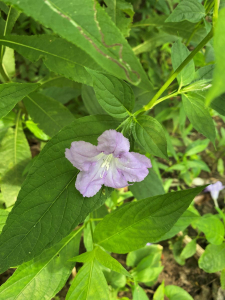
I spotted a patch of yellow mid-field several hundred feet from the trail. The responsible party is floating primrose-willow (Ludwigia peploides). Attractive from a distance, the flower and leaf venation pattern is absolutely, stunningly symmetric and complementary. I’m reminded once again of relevant da Vinci quote:
Human subtlety will never devise an invention more beautiful, more simple or more direct than does nature because in her inventions nothing is lacking, and nothing is superfluous.
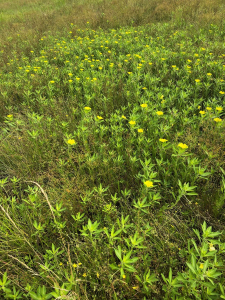
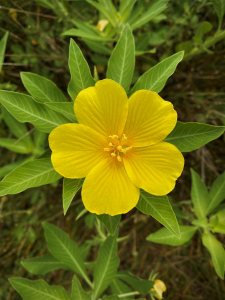
Like the wild petunia leaf miner, the pipevine swallowtail butterfly (Battus philenor) and Dutchman’s pipevine (Aristolochia macrophylla) are dependently interrelated. The adult butterfly deposits her eggs exclusively on pipevine stems. Her larvae feed solely on pipevine leaves. The nearly full-grown larva below will soon form its chrysalis on a pipevine stem. The adult will emerge in time to repeat the cycle.
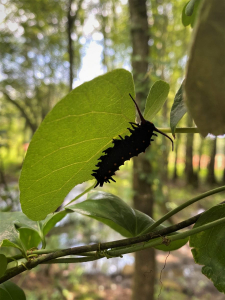
Let’s leap from the beautiful pipevine swallowtail (aka blue swallowtail; butterfly image at https://en.wikipedia.org/wiki/Battus_philenor) to what you may interpret as a sad story… another chapter in the book of life and death, written clearly in the language of Nature and hidden in plain sight. Bank-side at the south end of Jobala Pond we discovered a disturbed area of soil just over the embankment rim. The white debris (below left) in the apparently excavated soil are egg shell fragments. Just a few feet away we found broken entire egg shells. The story told is that a cooter or slider turtle deposited this spring egg clutch (they produce as many as six per year) in the bank, covered them with loose soil, and went about her merry way. In time, the turtlings (my word) hatch to fend for themselves. Instead, some mammalian marauder (skunk, weasel, or raccoon) found the nest, dug into the egg burrow, and messily consumed the egg contents. Evidence, I suppose, why these turtles lay multiple clutches. Life and death on the Sanctuary is a matter of fact.
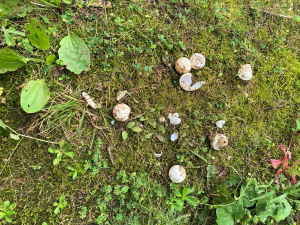
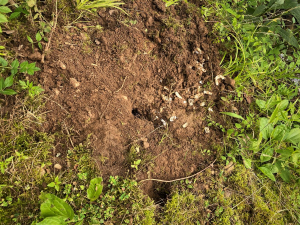
Sam held two of the eggs, fascinated with the tale… understanding the drama that had occurred overnight before our morning hike. The more we find when I explore Nature with him, the harder he looks for evidence of other tales. Holding the egg shells is far more compelling than seeing a photo in a reference book. He is, literally, in touch with Nature’s continuing saga of life and death. The only thing better would have been coming upon the marauder in the act!
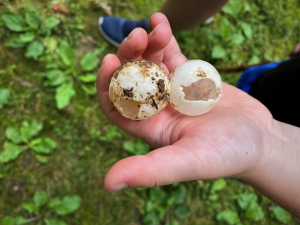
Nearby, with Murky Pond as backdrop, witness the excitement in our group as we found, this time, an intact eastern box turtle egg clutch.
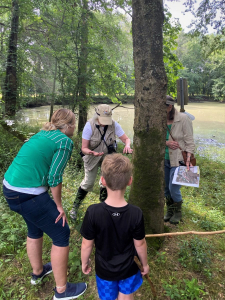
Marian allowed me to include the following three photos that she snapped: Sam pointing to the nest; closeup of the nest with two eggs visible; Sam’s hand softly holding the top egg.
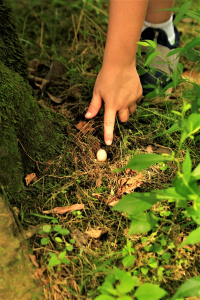
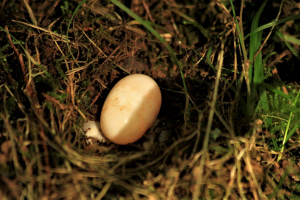
I was heartened to see such visible excitement among the adults in our entourage. We gingerly re-deposited the show-and-tell egg, placing a bit of leafy matter over it, hoping that some predator does not discover the eggs and enjoy a midnight snack before the turtles hatch. We humans seem to appreciate and celebrate new life, regardless of kingdom, phylum, class, order, family, genus, and species. A good sign giving me hope for human sustainability.
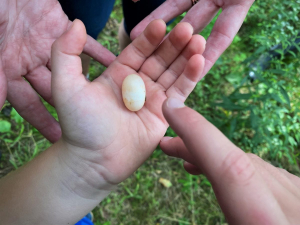
I write frequently about the hidden world of Nature — the beauty, magic, wonder, and awe that awaits those willing to look, see, and feel. Leonardo da Vinci elucidated the same 500 years ago:
Learn how to see. Realize that everything connects to everything else.
There are three classes of people: those who see. Those who see when they are shown. Those who do not see.
I want to open eyes with these Blog Posts — to encourage and implore people to look, see, feel, and then act as informed and responsible Earth stewards.
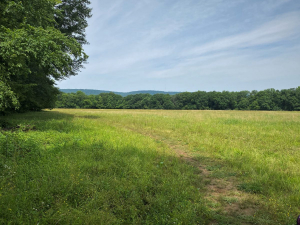
Nature is amazing, whether we view it from the perspective of a leaf miner or from within the larger context of the complex ecosystem pictured above.
The Flow of Life
Because the Sanctuary occupies the riparian zone along the Flint River, I’ll close with a pair of photos from the sand bar viewing down stream (below left) and up stream (right). Had we been standing here during the several flood events of the prior winter and spring, we would have been unceremoniously swept downstream with great violence as turbulent rushing torrents roiled ten feet above our heads.
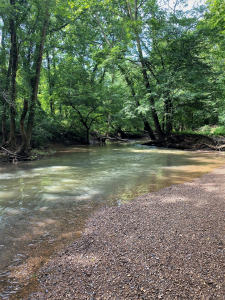
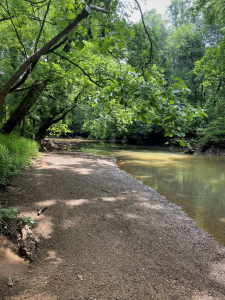
I mentioned in the prior Post about the river’s coming journey to the sea (from the Flint to the Tennessee to the Ohio to the Mississippi to the Gulf to the Atlantic. And once again, da Vinci captured the mystic essence of the flow of rivers and life:
In rivers, the water that you touch is the last of what has passed and the first of that which comes; so with present time.
Sam’s journey into the Sanctuary, like ours, began at the red gate (below). He started his trek through life six years ago, less than a tenth of my journey’s duration to date. Where will his flow through life lead? I earnestly pray that he will practice and proselytize informed and responsible Earth stewardship.
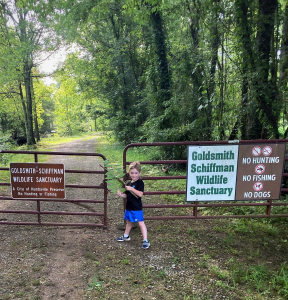
Perhaps he will see a time when a single (so-called intelligent) species will cease its seeming inevitable flow toward self-destruction.
Thoughts and Reflections
I borrow two simple truths from Leonardo da Vinci relevant to this visit to the Goldsmith Schiffman Wildlife Sanctuary:
Our life is made by the death of others.
Human subtlety will never devise an invention more beautiful, more simple or more direct than does nature because in her inventions nothing is lacking, and nothing is superfluous.
Inhale and absorb Nature’s elixir. May Nature Inspire, Inform, and Reward you!
Note: All blog post images created & photographed by Stephen B. Jones unless otherwise noted. Please circulate images with photo credit: “©2020 Steve Jones, Great Blue Heron LLC. All Rights Reserved.”
Another Note: If you came to this post via a Facebook posting or by an another route, please sign up now (no cost… no obligation) to receive my Blog Post email alerts: http://eepurl.com/cKLJdL
And a Third: I am available for Nature-Inspired Speaking, Writing, and Consulting — contact me at steve.jones.0524@gmail.com
Reminder of my Personal and Professional Purpose, Passion, and Cause
If only more of us viewed our precious environment through the filters I employ. If only my mission and vision could be multiplied untold orders of magnitude:
Mission: Employ writing and speaking to educate, inspire, and enable readers and listeners to understand, appreciate, and enjoy Nature… and accept and practice Earth Stewardship.
Vision:
- People of all ages will pay greater attention to and engage more regularly with Nature… and will accept and practice informed and responsible Earth Stewardship.
- They will see their relationship to our natural world with new eyes… and will understand more clearly their Earth home.
Tagline/Motto: Steve (Great Blue Heron) encourages and seeks a better tomorrow through Nature-Inspired Living!
Steve’s Three Books
I wrote my books Nature Based Leadership (2016), Nature-Inspired Learning and Leading (2017), and Weaned Seals and Snowy Summits: Stories of Passion for Place and Everyday Nature (2019; co-authored with Dr. Jennifer Wilhoit) to encourage all citizens to recognize and appreciate that every lesson for living, learning, serving, and leading is either written indelibly in or is powerfully inspired by Nature.
I began writing books and Posts for several reasons:
- I love hiking and exploring in Nature
- I see images I want to (and do) capture with my trusty iPhone camera
- I enjoy explaining those images — an educator at heart
- I don’t play golf!
- I actually do love writing — it’s the hobby I never needed when my career consumed me
- Judy suggested my writing is in large measure my legacy to our two kids, our five grand kids, and all the unborn generations beyond
- And finally, perhaps my books and Blogs could reach beyond family and touch a few others lives… sow some seeds for the future


All three of my books (Nature Based Leadership; Nature-Inspired Learning and Leading; Weaned Seals and Snowy Summits) present compilations of personal experiences expressing my (and co-author Dr. Wilhoit for Weaned Seals and Snowy Summits) deep passion for Nature. All three books offer observations and reflections on my relationship to the natural world… and the broader implications for society. Order any and all from your local indie bookstore, or find them on IndieBound or other online sources such as Amazon and LifeRich.

